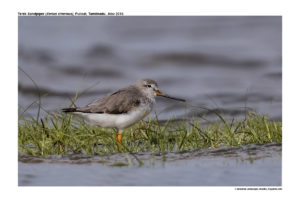Terek Sandpiper

Terek Sandpiper Xenus cinereus
Etymology:
- Xenus : Greek word for “Stranger”
- Cinereus : Latin word cinereusashcoloured
Vernacular Names: Guj:Tutvari, Chanchal, Dhariyayi, Ta: Uppukothiullan, Kadakaraiullan, Mal: Terek manaloothi, Mar: UlatchochTutari
Distribution in India: Widespread Winter visitor in Coastal India.
Description: Size of 22-25 cm. It has long upcurved bill and short orange to greenish-yellow legs; bobs rear body and has low flight, skimming over water with flicking downbeats to wings. It has grey-brown upperparts with almost black centers to feathers, particularly distinct on scapulars; streaked crown, hindneck, cheeks and sides of breast; broad white trailing edge to wings, but no wingbar. Some have shorter bills, not very obviously upcurved. The female averages slightly larger. The non-breeding adult is plainer; brownish grey above with pale fringes; paler head. The juvenile is like breeding adult, but upperparts are darker and browner with narrow buff fringes; black scapular lines are less prominent.
Habitat: It is found in lowland valleys, especially on floodplains with alternation of tall grasses and scrub willows; most typical on northern taiga and forest tundra. After breeding, found intropical coasts, especially open inter-tidal mudflats and estuaries, also coral reefs, sandy beaches, sandbars or mudflats at mouths of rivers, and coastal swamps and salt pans.
Food Habits: It eats adult and larval midges, as well as seeds during breeding .In non-breeding season eats insects, small molluscs, crustaceans including crabs, spiders and annelid worms. It has a rapid feeding action, with abrupt changes of direction; often teeters; pecks at sand or water surface; chases mobile prey on surface, also uses avocet-like sideways sweeping action; frequently probes; often washes prey in water’s edge. Usually feeds during low tide, but may also feed during high tide around embedded seaweed high on beach. It is scattered when feeding, in groups of 5–25 birds.
Breeding Habits: They breed in May-July Europe. They are monogamous (espl. the female), male exhibits polygamy. The nest is a shallow depression sparsely lined with grass and debris, in open or short vegetation, close to water.It lays a clutch of 2–5 eggs, with laying interval of 35-43 hours. The incubation period is 23-24 days. Incubation is done by both sexes, starting with third egg. The fledging period is 11-15 days and chicks are tended by both parents.